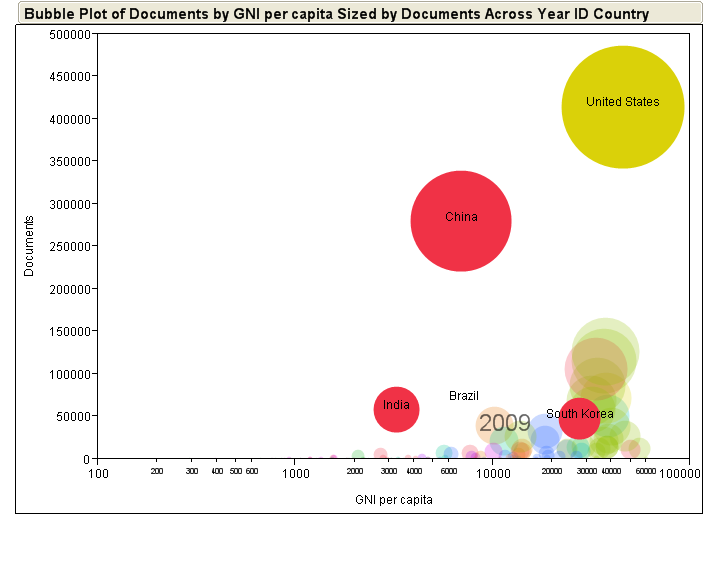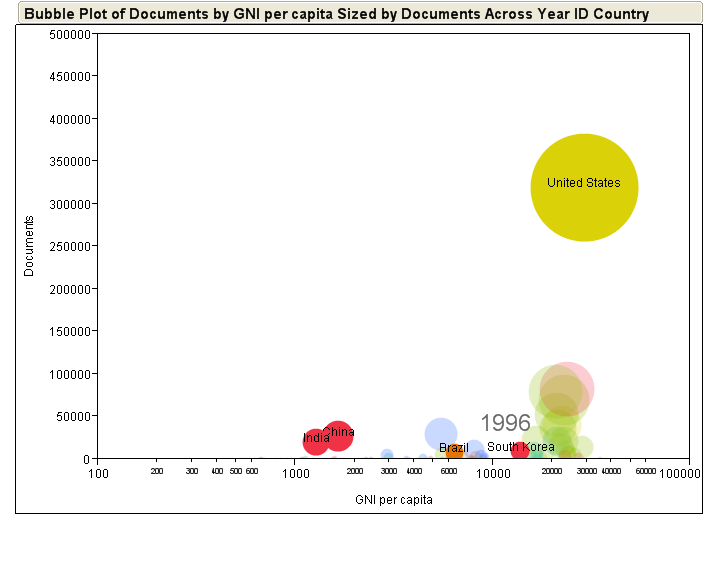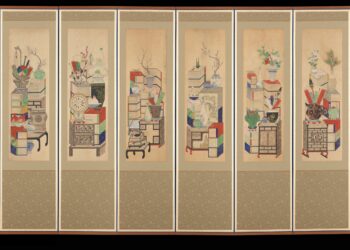
- Image by Stefans Photos via Flickr
Within a relatively few years, China has become an economic powerhouse. As of this year, China has surpassed Japan as the second-largest economy in the world — first place is still reserved for the United States . . . for now.
Along with its economic growth, China has also been investing heavily in R&D, and the result is a massive increase in scientific article production.
Data tables, like those appearing in the “2010 UNESCO Science Report,” provide adequate summaries of what is taking place in the world of science, but the data, printed in a static PDF, doesn’t really capture the dynamics of what has been taking place in the last few years.
Inspired by Hans Rosling’s visual relationship between income and lifespan, I create a bubble plot that compares publication output with a country’s economic status.
Publication data to create the bubble plot were derived from SCImago Journal & Country Rank while economic data came from the World Bank. The data sources were merged and plotted in JMP statistical software.
If you can view Adobe Flash files (unfortunately, I can’t publish Flash on the Scholarly Kitchen currently), you can watch the data in motion here. Remember to spend some time playing with the controls at the bottom.
To comprehend how China and a few other countries have changed over the last decade, the two images below should make the point. The size of the bubbles reflect the number of publications, and the countries have been coded to reflect their region (N. America=mustard; Asia=red; Green=W. Europe; Blue=E. Europe).
In 1996, science publishing was dominated by the United States, and collectively by wealthy countries that invested a lot in R&D and higher-education (Japan, UK, Germany, France, Spain, Canada, Italy, etc.). Note the position of three Asiatic countries (India, China and South Korea — all in red), and Brazil (in orange).
 The United States is still big, rich and productive, but look at how China, India, Brazil and S. Korea have changed. All are in the midst of experiencing great economic and scientific growth. If your browser can support Flash, watch the movie — it is worth a thousand static figures.
The United States is still big, rich and productive, but look at how China, India, Brazil and S. Korea have changed. All are in the midst of experiencing great economic and scientific growth. If your browser can support Flash, watch the movie — it is worth a thousand static figures.
(Thanks to Carlos Olmeda-Gómez from the SCImago Research Group.)
Discussion
30 Thoughts on "The Rise of China: Data Show How Science Follows Economic Growth"
Great graphic! Unfortunately some people are using China’s wonderful rise to claim America is declining. China’s gain is not our loss. There is no zero sum game here. This is not to say we couldn’t do more science.
Since the measurement of science here is published articles, I see this graphic as an indication of a country’s gift to the world. We in the United States benefit as much from Chinese publishing as they benefit from ours.
I am not sure whether this relationship can be seen as symmetric. At the moment, a lot of Chinese research/engineering can probably be seen as “we too/catch-up” research/engineering.
As one who studies science, I am not familiar with the concept of “we too/catch-up” research/engineering. How does this differ from normal science and engineering? (Phil — Is engineering even included in this analysis?)
David, with “we too/catch-up” research/engineering, I am mainly referring to incremental research/engineering (e.g., papers describing refinements).
Refinement as opposed to what? Breakthrough?Do you have a metric for this? We could certainty use one but I am not aware of any. What is your sample, such that you are seeing this?
Refinement (improving existing solutions to well-defined problems) as opposed to breakthrough/revolutionary research (opening new research directions and making fundamental changes). Obviously, “At the moment, a lot of Chinese research/engineering can probably be seen as “we too/catch-up” research/engineering.” is an opinion.
According to Kuhn’s model of science, almost all scientists are doing what you describe as refinement. He calls it normal science.
Moreover, most breakthroughs are not planned, as you suggest, rather they are surprises. I just had one, discovering that it seems that most scientists only publish one or two papers on any given problem. This finding contradicts one of the basic assumptions of my project, hence it is very surprising. Science is far more nomadic than we think.
“…Science is far more nomadic than we think.”
I would bet this has something to do with both funding source and duration as well as the job market.
Regarding this gift, I fathered a multi-language translation tool on OSTI’s global aggregation product: http://worldwidescience.org/multi/index.html
Your search term is translated into, say, Chinese, then the Chinese results are translated back into English. It is crude but it works so I am quite proud.
Interesting graphic! One obvious question is of course: how about the quality of Chinese publications? A big difference for instance exists between the USA and China in terms of citations per document:
http://www.scimagojr.com/countryrank.php
(a similar remark also holds true for the other countries cited in the entry above, like India, Brazil, and South Korea)
Really cool visualizations! How is the link between publication data and country established? Journals don’t typically ask this demographic when a paper is published.
The country link is made from the author address field in Scopus (and similarly in Web of Science).
So there could easily be an under-reporting of scholars from various countries who publish with the address of an institution they are attending rather than their home country.
China also suffers from a significant problem of plagiarism. Here is what i said in an article about China’s copyright dilemma published in Learned Publishing in 2008:
This low level of civic responsibility combines with another Confucian-derived value to exacerbate the problem even further: Chinese consider copying, not as a disreputable or dishonest activity, but as the traditional way for the individual to learn and gain mastery of a field. In China, students are taught that to become better writers they need to memorize and imitate the language and style of heralded past masters; such appreciation for the achievements of a long cultural tradition is supposed to help them become more creative, too. And it is not just students who are imbued with such ideas. Many of their professors (at least 60%, according to the government-owned China Daily) practice plagiarism in the belief that emulation of experts in their fields is the way to advance in their careers. Plagiarism is further encouraged by a system that pays professors based on the number, rather than quality, of the articles they publish.
Interesting perspective. Another contributing factor is the fact that ‘shame’ is the most important moral and social value in Confucian cultures (e.g., China and Korea), whereas ‘guilt’ is the most important moral value in Western Christian cultures. Shame is external, and guilt is internal. Simply speaking, in a Confucian culture, you can basically do anything as long as others are not able to find out about this. In a Western Christian culture, you can basically do anything as long as you do not feel guilty about it.
A similar reasoning holds true for values such as ‘truth’ and ‘loyalty’. In Confucian cultures, truth and doing the right thing are not ranked as important as the maintenance of relationships.
Your theory of morality is as strange as your theory of science (assuming you are the same nameless anonymous). Guilt is not a moral value, it is a feeling. Honesty is a moral value. Nor is truth is a moral value, rather it is a property of propositions. Telling the truth, and not telling it (when appropriate), are moral values.
But then, if you believe that you “can basically do anything as long as you do not feel guilty about it,” it is obvious why you do not understand moral values. The jails are full of people who think this way.
I agree that I should have been more careful in my wording. Nonetheless, I think the essence of my comment remains the same. At least, it helped me better understanding the Confucian environment I am living and working in.
Given the importance of shame in Confucian cultures, open peer review may for instance help dealing with plagiarism…




